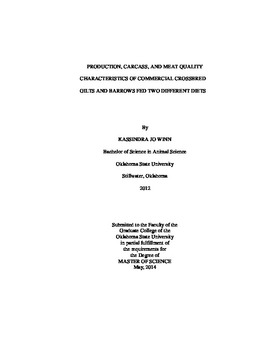| dc.description.abstract | This study analyzed the characteristics of commercial crossbreds by gender and diet on carcass merit by evaluation of cutability and palatability attributes of fresh pork. Duroc � Landrace � Yorkshire (commercial crossbred) barrows and gilts (n = 67) were utilized, and fed one of two corn based diets, with one containing 14% wheat midds (diet 1) and the other combining 12% soybean meal and 9 g per ton of Paylean� (diet 2). Hogs were harvested at the Oklahoma State University Food Agriculture Processing Center. Prior to slaughter, ultrasonic measurements of loin eye area (LEA) and 10th rib fat depth (n = 88) were collected, and days of age, live weight and ADG were recorded for each hog. Carcass characteristics including pH, hot carcass weight (HCW), fat depth, LEA, and quality attributes were measured, and fat free lean (FFL), % FFL, and U.S. Grade were calculated for each carcass. A trained sensory panel evaluated cooked chops for juiciness, tenderness, and pork flavor. Barrows were faster growing with a higher ADG (P < 0.05) and were numerically 1.51 kg heavier (P > 0.05). No differences were observed between diet 1 and 2 for live weight (P = 0.37) and ADG (P = 0.29). Numerically, gilts had larger LEA, lower dressing %, and greater FFL (P > 0.05). Barrows had numerically heavier HCW and higher MS (P > 0.05), but were fatter opposite the first and last rib, last lumbar vertebra (LLV), and 10th rib, and calculated lower %FFL and higher U. S. Grade (P < 0.05). There were no differences (P = 0.28; P = 0.22) in HCW between gender and diet. Hogs fed diet 1 had numerically heavier HCW, less fat over LLV, larger LEA, and calculated higher FFL, % FFL, and lower U. S. Grade (P > 0.05). Gender or diet had no impact on quality attributes or 1 hr, 3 hr, and 24 hr pH values. There were gender � diet interactions (P < 0.05) for initial/sustained juiciness and tenderness and pork flavor. Data suggests carcass merit and production were maximized by diet and gender, without sacrificing quality attributes. | |
